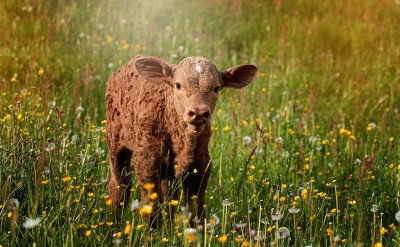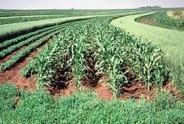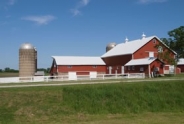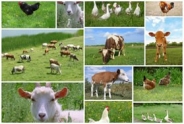Selection for Calving Ease
Amy Barkley, Team Leader & Livestock Specialist
Southwest New York Dairy, Livestock and Field Crops Program

Selection for Calving Ease
Mark Z. Johnson, Oklahoma State University Extension Beef Cattle Breeding Specialist
With bull turnout and breeding season in mind, we continue to discuss considerations about the bulls we'll be turning out. Specifically, selection for calving ease. If we intend to breed a set of heifers this spring, calving ease becomes an economically important trait in our next calf crop. Dystocia (calving difficulty, typically caused by a large or awkwardly positioned fetus) is far more likely to occur in first calf heifers and typically not a significant issue in mature beef cows. With no dystocia, calf death loss within 24 hours of birth is less than 5% but this percentage can increase by as much as 2 - 4 times if calving assistance is required. Heifers that calve unassisted do a better job of raising that calf, have shorter rebreeding intervals and calf earlier the following year. Obviously, we would like to avoid calving difficulty and if we have identified it as a priority, several selection tools are available.
First, sire selection is critical. Over time, 90% of genetic change is a result of sire selection because bulls sire more calves in a breeding season than a cow will produce in her lifetime. Effective sire selection should be based on EPDs resulting from genetic prediction. Selection based on EPDs is 7 - 9 times more effective than selection based on weights or within herd ratios alone. EPDs are more effective because they are calculated based on individual weights, within herd ratios, pedigree relationship and the performance of all relatives, as well as DNA.
So when calving ease is important consider the following EPDs: Calving Ease Direct (CED), is expressed as a difference in percentage of unassisted births, with a higher value indicating greater calving ease in first-calf heifers. It predicts the average difference in ease with which a sire's calves will be born when he is bred to first-calf heifers. Example: - Bull A has CED of 5 - Bull B has a CED of 16 If we mate both bulls to a set of virgin replacement heifers, we are 11% less likely to pull a calf sired by bull B Birth Weight EPD (BW), expressed in pounds, is a predictor of a sire's ability to transmit birth weight to his progeny compared to that of other sires. Example: - Bull C has a Birth Weight EPD of -0.7 - Bull D has a Birth Weight EPD of 3.3 Calves sired by bull C will weigh 4 lbs. less at birth, on average
If you will be keeping replacement heifers sired by bulls you'll be turning out this year, consider:
Calving Ease Maternal (CEM), is expressed as a difference in percentage of unassisted births with a higher value indicating greater calving ease in first-calf daughters. It predicts the average ease with which a sire's daughters will calve as first-calf heifers when compared to daughters of other sires. Because it is a trait expressed when the bull's daughters are having their first calves it is a "next generation" maternal predictor. Example - Bull E has a CEM of 8 - Bull F has a CEM of 13
If we are calving out the daughters of both bulls which are mated to the same sire, we are 5 % less likely to pull a calf from one of bull F's daughters
Bottom line: Selection of genetically superior sires is the fastest approach to herd improvement and profitability. Genetic improvement is cumulative and permanent. Investing in improved genetics now will pay dividends for generations to come.
To view Dr. Johnson's segment on Sunup TV Cow-Calf Corner from March 13, 2021 on using EPDs for bull selection to improve your herd: Cow-Calf Corner - EPDs 3/13/21 — SUNUP TV (okstate.edu)
To receive "Cow/Calf Corner", contact email Paul Beck (paul.beck@okstate) or Derrell Peel (derrell.peel@okstate.edu) to get added to our email list.
Upcoming Events
Crops, Cows & Critters - Southwest New York Dairy, Livestock & Field Crops Newsletter Sponsorship
December 19, 2025
January 30, 2026
Our two forms of publications feature research-based and timely information from our four specialists, listed to the right, along with local event notifications and Cornell University outreach. This information is provided to participants who range from dairy, livestock, and field crops producers to agricultural suppliers and consultants.
Weekly Email Update: Shared with 625+ households who have signed up with our program.
Monthly Paper Mailer: To reach our stakeholders and farmers who lack internet access, we send out a monthly mailer where your company's logo and contact information would be featured with a mailing list of 330+ households.
If you sponsor our weekly and monthly publications you reach approximately 955 households.
Visit our website to view our newsletters!
2025 Cornell Food Beverage & Animal Feed Manufacturer Survey
December 19, 2025
Industry and Educational Advocates for New York State's Food, Beverage, and Animal Feed Manufacturing industries:
As you know, NYS has a diverse food and beverage manufacturing industry, in both the types of industries that exist and the wide distribution of firms by scale. Many manufacturing firms have strong backward linkages to agricultural production sectors in the state that support both farm-level and downstream food industry firms and consumers. In collaboration with the New York State Department of Agriculture and Markets, a team from Cornell University's Charles H. Dyson School of Applied Economics and Management has recently rolled out the 2025 New York State Food, Beverage, and Animal Feed Manufacturer Survey. The industry will benefit from an updated assessment of the industry that informs private and public investments and opportunities to support firm growth and improved profitability.
Boots in the Barn: Cornell Dairy Research Updates
January 13, 2026
January 20, 2026
January 27, 2026
February 3, 2026
February 10, 2026
February 17, 2026
February 24, 2026
Join us for some or all!
Announcements
No announcements at this time.





